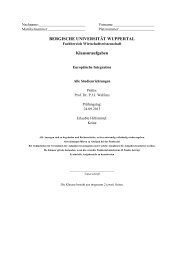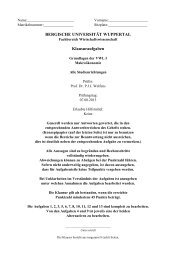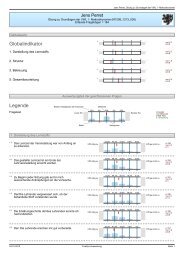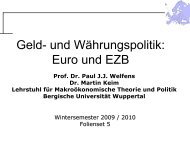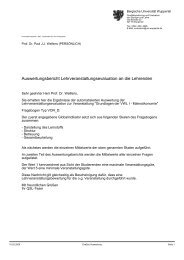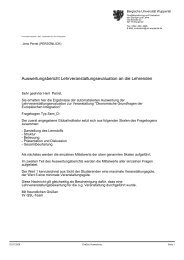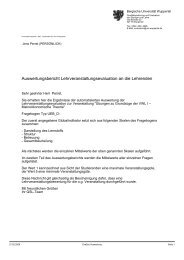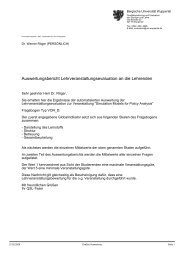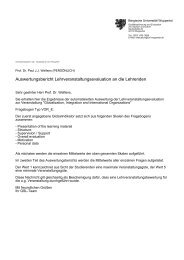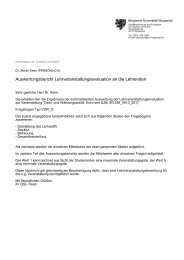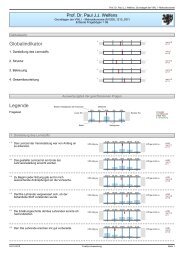UNIVERSITÄT POTSDAM - Prof. Dr. Paul JJ Welfens
UNIVERSITÄT POTSDAM - Prof. Dr. Paul JJ Welfens
UNIVERSITÄT POTSDAM - Prof. Dr. Paul JJ Welfens
Create successful ePaper yourself
Turn your PDF publications into a flip-book with our unique Google optimized e-Paper software.
the presence of relative price changes – for real GDP measurement showed that real<br />
GDP growth had to be slightly revised downwards. At the same time the introduction<br />
of hedonic pricing which takes into account quality improvement – highly significant in<br />
the ICT sector (especially in the case of computers) – brought an upwards revision of<br />
real GDP. One can only wonder why Eurostat is not making similar adjustments in its<br />
SNA procedures.<br />
We now turn to the analysis of output growth on the basis of factor inputs and<br />
total factor productivity (TFP) growth. The US recorded in some years two-digit<br />
growth rates of total factor productivity growth in the 1990s. Overall TFP is the<br />
weighted sum of sectoral TFPs, that in our case is of two sectors; here αi (i=1,2) is the<br />
share of nominal sector 1 output relative to overall nominal output.<br />
(V) TFP = α1 TFP1 + α2 TFP2<br />
In a simple growth model based on a production function VF(K,L,Z,Q) with inputs<br />
capital K (without computers), labor L and computers Z we can decompose output<br />
growth as follows where we use EY,X to denote partial output elasticities:<br />
(V.I) gY = EY, K g K + EY,LgL + EY,Z gZ + gV; here gV= TFP<br />
(V.II) gY = EY, K g K + EY,LgL + EY,Z gZ + α1 TFP1 + α2 TFP2<br />
The input factor computer is a proxy for ICT goods used as inputs in firms. Total<br />
factor productivity growth in the ICT sector has been enormous in the 1990s in the<br />
US and is expected to remain high; while the EU also has had an increase in productivity<br />
growth in ICT it is unlikely that West European countries will be on par with the<br />
US. It is true that Sweden, Finland, Ireland and some regions in Germany and France<br />
have a dynamic ICT industry, but global industry leaders clearly are firms from the US<br />
which also spend more than twice as much as the Europeans on software (OECD,<br />
1998). While it is unlikely that the US lead in ICT will continue forever, it might well<br />
maintain a considerable lead over several decades.<br />
Next we turn to the issue of heterogeneous labor; that is, we will distinguish between<br />
unskilled labor L and skilled labor H. The substitution elasticity of L and H with<br />
respect to computers is crucial, and here again we might find differences in the US and<br />
Europe. However, even if the substitution elasticity in the US would be higher than in<br />
the EU high investment in ICT would not necessarily mean a rise of unskilled unemployed<br />
in the US. The crucial question is whether the labor market is flexible enough to<br />
transitorily allow wage rates of unskilled labor to fall – with employment growth and<br />
25



